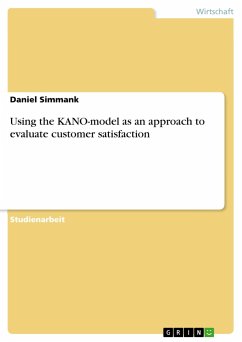Studienarbeit aus dem Jahr 2013 im Fachbereich BWL - Offline-Marketing und Online-Marketing, Note: 1,3, AKAD University, ehem. AKAD Fachhochschule Stuttgart, Sprache: Deutsch, Abstract: As the improvement of customer satisfaction is a very actual, important and complex topic for most companies, the goal of this assignment is to analyze how the Kano-Model can be used to determine the customers' satisfaction and their needs in a structured approach. In order to achieve this goal, the theory behind the main terms will be explained in chapter 2. Chapter 2.1 will feature a discussion of the term "customer satisfaction" in order to give a better understanding of how customers react to the companies' products. This is followed by an explanation of the term product quality in chapter 2.2, in order to give a short overview of factors that might influence the customers' satisfaction. In chapter 3 the Kano-Model will be discussed in-depth. Chapter 3.1 will give a general overview of what the Kano-Model is and what different quality-categories exist within it. Afterwards the process of analyzing customer preferences will be shown in chapter 3.2. Lastly, chapter 3.3 will evaluate the usefulness of the model in the given context. Chapter 4 will conclude this work by presenting the essential findings and reflecting the used approach.








